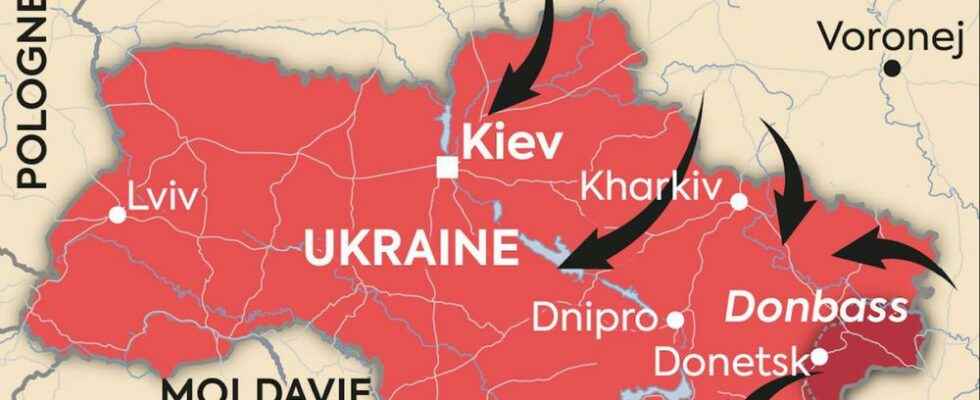The Russian invasion seems (almost) total. “No, this is not a Russian invasion only in eastern Ukraine, but a large-scale attack”, in particular tweeted Ukrainian Foreign Minister Dmytro Kuleba, early in the morning, and later denouncing “the most flagrant act of aggression in Europe since the Second World War”. Some images are already filtering on the ground, especially on social networks. The point, region by region.
Russia attacked Ukraine by not just invading Donbass.
Infographic L’Express
In the area, source of the conflict, and occupied by pro-Russian factions since 2014, the images are for the moment rather rare. Ukrainian soldiers are mobilized near Luhansk and Donetsk, in order to repel the separatists and the armed forces coming directly from Russia.
Ukrainian soldiers prepare to repel an attack in the Luhansk region, Ukraine, February 24, 2022.
AFP
Other scenes are emerging on social networks, coming from the south of the region, and in particular from Mariupol, on the shores of the Sea of Azov, where bombings took place.
Where the war has never really stopped for eight years.
As noted, the clashes are not limited to eastern Ukraine. The Kharkiv region is also under Russian fire. Several images circulated this Thursday, where buildings but also a military airport were targeted.
Firefighters work on a fire on a building after shelling in the eastern Ukrainian city of Chugiv on February 24, 2022.
AFP
Black smoke rises from a military airport in Chuguyev, near Kharkiv, on February 24, 2022.
AFP
Russian pressure is also being felt in the south of the country. In the regions of Kherson and Odessa, on the shores of the Black Sea, and not far from the annexed Crimea, bombings took place. Other videos suggest Russian troop movements from the south (Crimea) to the north. And traces of early battles between Ukrainian and Russian forces.
Russian military units entered the Kyiv region from Belarus to carry out an attack with Grad missiles on military targets, Ukrainian border guards said in a statement on Thursday. The border guards, without specifying the nature of this land incursion, added that it had taken place through the Vilcha checkpoint, about 150 kilometers north of the capital.
Much closer, just 15 kilometers from Kiev, early reporters report a takeover of the Antonov military airport.
In the morning, a military plane also crashed about twenty kilometers from the capital. The causes are still unknown.
A Ukrainian military plane with 14 people on board crashed south of Kiev on Thursday, the emergency service said. The service said it was “still determining how many people died”. The incident happened about 20 kilometers (12 miles) south of Kyiv, amid reports of attacks at several sites around the city.
AFP
In the capital, the queues to withdraw money are getting longer, to the rhythm of the air raid sirens that sound in the city.
People line up to withdraw cash from an ATM in Kyiv on the morning of February 24, 2022. Air raid sirens sounded in downtown Kyiv on Thursday.
AFP
For now, only the western part of the country, bordering Poland, Hungary but also Romania, seems to have been spared the fighting. In Lviv, however, tension is mounting, and the lines at gas stations are getting longer and longer, a sign of possible population movements, inside or outside the country. As a reminder, Europe fears, on the sidelines of this conflict, a new refugee crisis.
People line up at a gas station in the western Ukrainian city of Lviv on February 24, 2022.
AFP
